𝗠𝗔𝗥𝗟𝗢𝗧𝗛 𝗣𝗔𝗥𝗞 – 𝗔 𝗕𝗜𝗥𝗗𝗜𝗡𝗚 𝗛𝗢𝗧𝗦𝗣𝗢𝗧 |
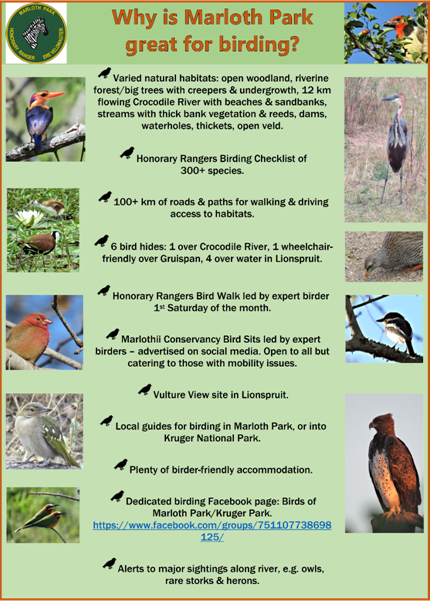
𝘕𝘪𝘤𝘢𝘵𝘰𝘳 𝘨𝘶𝘭𝘢𝘳𝘪𝘴
EASTERN NICATOR
A: Geelvleknikator
This handsome, sought-after bird, the only southern African nicator, occurs in just a tiny sliver of the north-eastern border of South Africa.
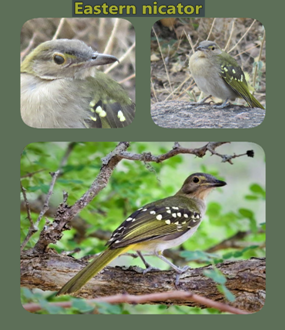
Size: 20 -23 cm
𝗞𝗲𝘆 𝘃𝗶𝘀𝘂𝗮𝗹 𝗜𝗗 𝗽𝗼𝗶𝗻𝘁𝘀: Similar look to shrikes and greenbuls. Olive green with buffy white throat and yellowish vent, breast greenish grey; yellow tips to wing coverts and tertials. Green shines in right light; striking yellow-gold spots on coverts. Yellow tail tips visible in flight. Dark brown eye; strong hooked bill, as in shrikes. Sexes the same.
𝗖𝗮𝗹𝗹: Unmistakeable, explosive, jumble of ‘electrical’ notes. In winter usually just a loud ‘chuck chuck chuck’ contact call. Calls often.
𝗛𝗮𝗯𝗶𝘁𝗮𝘁: Dense woodland and thickets, usually fairly low down.
𝗗𝗶𝗲𝘁: Insects gleaned from bushes and understory of trees.
𝗡𝗲𝘀𝘁: Small platform hidden 1-2 m up in thicket.
𝗢𝗰𝗰𝘂𝗿: Extreme NE of SA into Mozambique.
𝗦𝘁𝗮𝘁𝘂𝘀: Fairly common resident.
𝗣𝗹𝗮𝗰𝗲𝘀 𝘁𝗼 𝘀𝗲𝗲 𝗶𝘁 𝗵𝗲𝗿𝗲: Occur everywhere where there is suitable thick, tangled vegetation, e.g. reported at Kudu/Kiaat corner, at Cheetah/Kameelperd corner, off Olifant and in Ribbok.
𝗕𝗶𝗿𝗱𝗶𝗻𝗴 𝘁𝗶𝗽𝘀: A tricky find, as its skulking behaviour and colouring make it hard to spot in the thickets and trees it favours, especially when looking upwards into canopy. (See last three photos for it in typical habitat – difficult to get a photo without twigs and foliage!) Prepare by knowing the call, which is loud and repeated, and track it via that. When foraging it hops about giving flicks of dropped wings. It does sometimes come out into the open – as in the first two photos.
𝘗𝘳𝘪𝘰𝘯𝘰𝘱𝘴 𝘱𝘭𝘶𝘮𝘢𝘵𝘶𝘴
WHITE-CRESTED HELMET-SHRIKE
𝘗𝘳𝘪𝘰𝘯𝘰𝘱𝘴 𝘳𝘦𝘵𝘻𝘪𝘪
RETZ’S HELMET-SHRIKE
You may encounter these charming birds, with their whacky wattle-eyes, all over Marloth Park. The two species are often seen together, and commonly join bird parties. An easy, fun find.
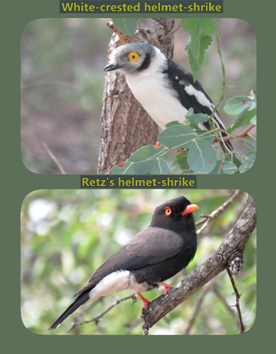
Si𝘇𝗲: 19 – 24 cm (Retz’s the slightly bigger species)
𝗞𝗲𝘆 𝘃𝗶𝘀𝘂𝗮𝗹 𝗜𝗗 𝗽𝗼𝗶𝗻𝘁𝘀: White-crested: white breast and collar and black and white wings, erect whitish forecrown and grey hind crown, with dark edge below eye. Bright yellow ‘frilled’ wattle round yellow eye; black bill, orange legs.
Retz’s: Black body and crest, dark brown back and wing coverts, white vent and undertail coverts. Deep red ‘frilled’ wattle round yellow eye. Red bill and legs.
𝗖𝗮𝗹𝗹: White-crested: Electrical clicks, chattering and bubbling sounds very noticeable, chorused in the group. Repeated ‘cherow’.
Retz’s: Harsher notes with more clicks than the white crested. ‘Tweeer’ call.
𝗛𝗮𝗯𝗶𝘁𝗮𝘁: White-crested in woodland and savannah; Retz’s in woodland and riverside forest.
𝗗𝗶𝗲𝘁: Insects, other invertebrates, small lizards.
𝗡𝗲𝘀𝘁: Cup nest in fork of canopy of tall tree. Breed co-operatively.
𝗢𝗰𝗰𝘂𝗿: Far NE of SA into Zimbabwe, Botswana, Mozambique.
𝗦𝘁𝗮𝘁𝘂𝘀: Common resident.
𝗣𝗹𝗮𝗰𝗲𝘀 𝘁𝗼 𝘀𝗲𝗲 𝗶𝘁: Anywhere where there are trees but also, e.g. often along the Seekoei. Usually in the mid stratum of trees but also low down, and on the ground.
𝗕𝗶𝗿𝗱𝗶𝗻𝗴 𝘁𝗶𝗽𝘀: They forage in bands, constantly on the move, the fluttering black and white wings (the white-crested) very noticeable. If they have just found a caterpillar, they can be seen bashing it against a branch to get rid of the prickles. You quickly get to learn and notice their unusual calls and can track that to find them too.
𝘛𝘢𝘶𝘳𝘢𝘤𝘰 𝘱𝘰𝘳𝘱𝘩𝘺𝘳𝘦𝘰𝘭𝘰𝘱𝘩𝘶𝘴
PURPLE-CRESTED TURACO
These striking forest birds can be heard calling loudly as they forage for fruit all over Marloth Park.

𝗦𝗶𝘇𝗲: 41-43 cm
𝗞𝗲𝘆 𝘃𝗶𝘀𝘂𝗮𝗹 𝗜𝗗 𝗽𝗼𝗶𝗻𝘁𝘀: Big; dark colouration but iridescent navy/purple back and tail in right light; green and pale orange-rose chest; emerald green and purple crest; red wings in flight; red eye ring; strong bill dark grey.
𝗖𝗮𝗹𝗹: Loud ‘kok kok kok!’
𝗛𝗮𝗯𝗶𝘁𝗮𝘁: Big trees, especially when fruiting
𝗗𝗶𝗲𝘁: Fruit; insects
𝗡𝗲𝘀𝘁: Twig platform in tree canopy or dense creeper
𝗢𝗰𝗰𝘂𝗿: In far NE of SA and down to Southern KwaZulu-Natal
𝗦𝘁𝗮𝘁𝘂𝘀: Common non-migrant
𝗣𝗹𝗮𝗰𝗲𝘀 𝘁𝗼 𝘀𝗲𝗲 𝗶𝘁 𝗵𝗲𝗿𝗲: Occur everywhere where there are suitable fruiting trees but more often found on e.g. large fruiting jackalberrys and figs along the Crocodile River.
𝗕𝗶𝗿𝗱𝗶𝗻𝗴 𝘁𝗶𝗽𝘀: Follow sounds, look for flash of red wings as they fly. They jump around in the big tree canopies, seldom perch for long.
𝘌𝘱𝘩𝘪𝘱𝘱𝘪𝘰𝘳𝘩𝘺𝘯𝘤𝘩𝘶𝘴 𝘴𝘦𝘯𝘦𝘨𝘢𝘭𝘦𝘯𝘴𝘪𝘴
SADDLE-BILLED STORK
Head to the Crocodile River-side walks to see this magnificent stork. It is a sought-after species for birders as it occurs only in a sliver of north-eastern South Africa. There are plenty sighted in Marloth Park, by looking through the fence down to the river, and you may be lucky enough to see a fly-by. Note: this is classified as an Endangered Species.
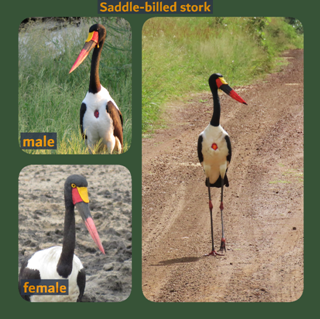
𝗦𝗶𝘇𝗲: 140-150 cm; about 6 kg
𝗞𝗲𝘆 𝘃𝗶𝘀𝘂𝗮𝗹 𝗜𝗗 𝗽𝗼𝗶𝗻𝘁𝘀: This bird is unmistakeable: very tall, with dramatic black and white plumage. It has a huge red bill with a black band and bright yellow ‘saddle’, and black legs with pink knees. In flight the black wings have a broad trailing edges of white. A little trick to remember sexes: males have dark brown eyes, females have golden yellow ‘wedding ring’ irises. Males have two small dangling yellow wattles. In the centre of the chest of both species is a circle of bare skin that darkens during breeding season.
𝗖𝗮𝗹𝗹: Silent. May clap the bill when displaying.
𝗛𝗮𝗯𝗶𝘁𝗮𝘁: Freshwater rivers, lakes and dams.
𝗗𝗶𝗲𝘁: Mostly fish but also invertebrates, frogs, small reptiles and mammals and birds.
𝗡𝗲𝘀𝘁: Big platform of sticks and mud and other vegetation in a tall tree.
𝗢𝗰𝗰𝘂𝗿: Far NE of SA into Zimbabwe, Botswana, Mozambique.
𝗦𝘁𝗮𝘁𝘂𝘀: Uncommon resident.
𝗣𝗹𝗮𝗰𝗲𝘀 𝘁𝗼 𝘀𝗲𝗲 𝗶𝘁 𝗵𝗲𝗿𝗲: Anywhere along the river where it can land and hunt for fish.
𝗕𝗶𝗿𝗱𝗶𝗻𝗴 𝘁𝗶𝗽𝘀: If present this is an easy find – even non-birders notice them. They may be in pairs or alone. The Marloth Sightings Groups often give alerts to them.
𝘊𝘢𝘭𝘢𝘮𝘰𝘯𝘢𝘴𝘵𝘦𝘴 𝘴𝘵𝘪𝘦𝘳𝘭𝘪𝘯𝘨𝘪
STIERLING’S WREN-WARBLER
You’ll hear this busy little woodland bird’s clear, ringing call easily and often, but to track it down … tricky! It is a very sought-after species for birders as it occurs only in a tiny sliver of north-eastern South Africa. There are plenty in Marloth Park.
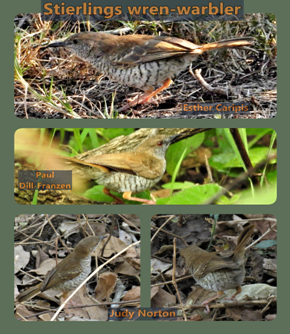
STIERLING’S WREN-WARBLER 𝘊𝘢𝘭𝘢𝘮𝘰𝘯𝘢𝘴𝘵𝘦𝘴 𝘴𝘵𝘪𝘦𝘳𝘭𝘪𝘯𝘨𝘪 A: Stierlingsanger
𝗦𝗶𝘇𝗲: 13 cm; about 13 g
𝗞𝗲𝘆 𝘃𝗶𝘀𝘂𝗮𝗹 𝗜𝗗 𝗽𝗼𝗶𝗻𝘁𝘀: This sprightly little bird has an erect stance and rather long tail that it usually holds upright. Its back and tail are a mid brown but it has eye-catching, neat, dark barring on its creamy white underparts. The brown upper wing coverts are tipped paler, and the median coverts are tipped with whitish spots. It has rich brown to orange eyes, a small black bill and pinky-brown, longish legs and feet.
𝗖𝗮𝗹𝗹: Distinctive, high-pitched, fast, repeated tilip! tilip! tilip! that carries far.
𝗛𝗮𝗯𝗶𝘁𝗮𝘁: Dense vegetation in woodland, and thickets round termite mounds.
𝗗𝗶𝗲𝘁: Usually forages on or near the ground, gleaning tiny insects from plants and leaf litter. Also seen at the edges of the canopy.
𝗡𝗲𝘀𝘁: The ball-shaped nests are built in the middle of small trees, made of thick ‘felted’ plant fluff, and fine grass, bound by spider web. Plus, interestingly, they sew some living leaves into the construction.
𝗢𝗰𝗰𝘂𝗿: Far NE of SA into Zimbabwe, Botswana, Mozambique.
𝗦𝘁𝗮𝘁𝘂𝘀: Fairly common resident.
𝗣𝗹𝗮𝗰𝗲𝘀 𝘁𝗼 𝘀𝗲𝗲 𝗶𝘁 𝗵𝗲𝗿𝗲: Anywhere where there are the right, mid-sized trees, such as known sightings all along Kudu, Kiaat, Renoster, Sekelbos and Swartwitpens Roads, but also in stands of big trees. Three of the photos were taken in Henk van Rooyen Park, two among the leaf litter under the big trees lining the gulley by the swimming pool. One was taken in Swartwitpens close to Njala corner.
𝗕𝗶𝗿𝗱𝗶𝗻𝗴 𝘁𝗶𝗽𝘀: Learn the call then track them down. It is a fairly challenging bird to find as it is small and constantly on the move, seldom out in the open. It can be hard to get a clear photo. Wren-warblers can be seen singly, in pairs, or groups, and sometimes join bird parties foraging for insects.
𝘉𝘶𝘣𝘰 𝘭𝘢𝘤𝘵𝘦𝘶𝘴 Reuse-ooruil
VERREAUX’S GIANT EAGLE-OWL
This largest of all African owls is often heard and spotted in both our woodland and our riverine forest. It is restricted to the north of South Africa, bar a small area on the south-east coast, so is a sought-after species.
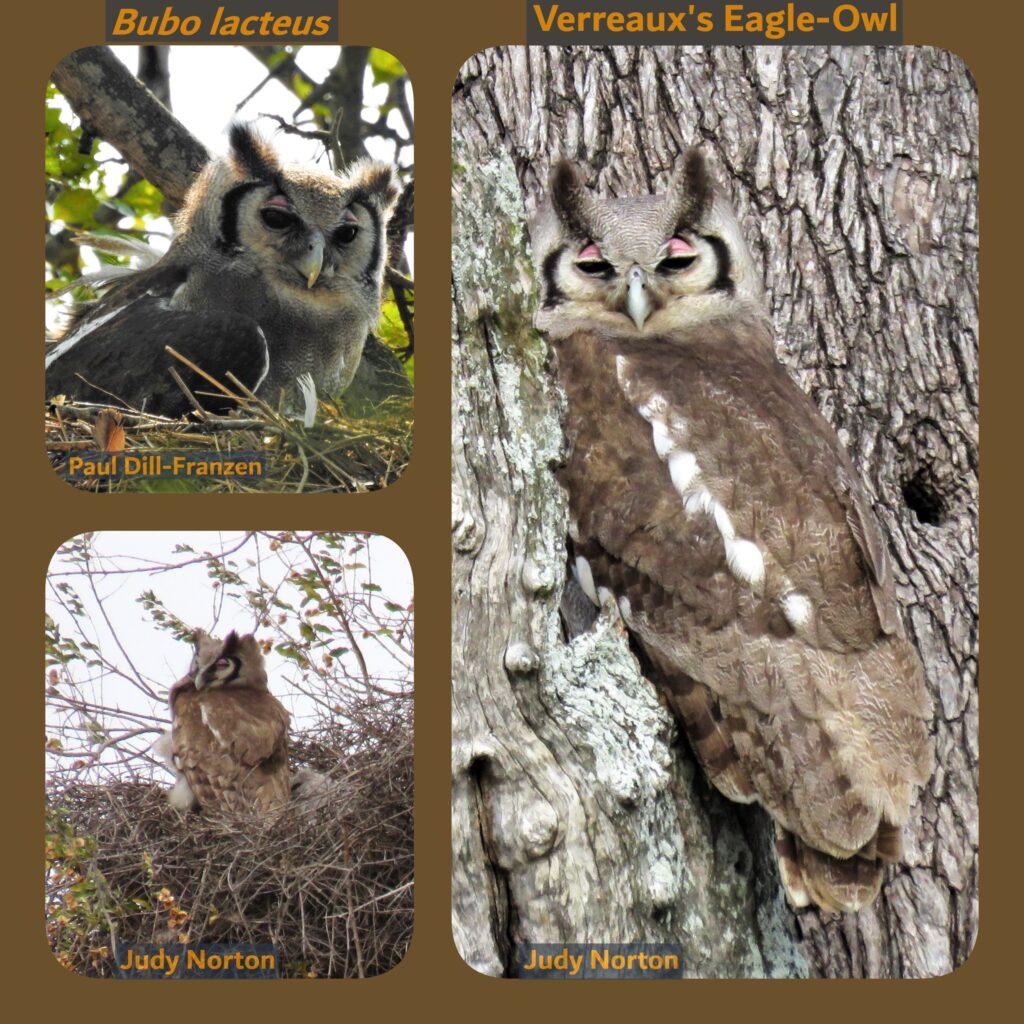
𝗦𝗶𝘇𝗲: up to 66 cm; about 1,2 – 3 kg
𝗞𝗲𝘆 𝘃𝗶𝘀𝘂𝗮𝗹 𝗜𝗗 𝗽𝗼𝗶𝗻𝘁𝘀: The sheer size of this bird makes it easy to spot. As with most owls, look for the erect ‘owl-shape’ on a horizontal branch in trees, in this case the head with shortish ‘ear-tufts’ (which are not actually ears, just feather features). It has beautiful, fine, white and grey vermiculation on the pale grey-brown plumage. Very striking are the creamy facial discs edged with black, in the centre of which are dark brown eyes with unique pink eyelids.
𝗖𝗮𝗹𝗹: Deep pig-like grunting: uhn uhn uhn! But also hooting during courtship; young whistle for food.
𝗛𝗮𝗯𝗶𝘁𝗮𝘁: Riverine forest, broad-leafed woodland, savanna, thornveld.
𝗗𝗶𝗲𝘁: Predates on a wide variety of smaller mammals, reptiles and other birds, up to 2 or so kg.
𝗡𝗲𝘀𝘁: Uses old raptor or crow nests, or the tops of hamerkop or buffalo weaver nests.
𝗢𝗰𝗰𝘂𝗿: N of SA into Zimbabwe, Botswana, Mozambique.
𝗦𝘁𝗮𝘁𝘂𝘀: Fairly common resident.
𝗣𝗹𝗮𝗰𝗲𝘀 𝘁𝗼 𝘀𝗲𝗲 𝗶𝘁 𝗵𝗲𝗿𝗲: Regularly spotted along the river on Seekoei, and reported in the sightings groups; a pair has been seen and heard several times around the Luiperd/Ribbok area; a pair seen in Lionspruit, at Impala Dam; heard around Bosbok area.
𝗕𝗶𝗿𝗱𝗶𝗻𝗴 𝘁𝗶𝗽𝘀: These huge birds prefer huge trees: always scan up into big trees and tall, dead trees when birding. Learn the call then listen for it in the evening and early morning. You will often be hearing a duet. If you don’t have a birding app that has calls, Xeno Canto is a wonderful free online resource: https://xeno-canto.org/species/Bubo-lacteus.
